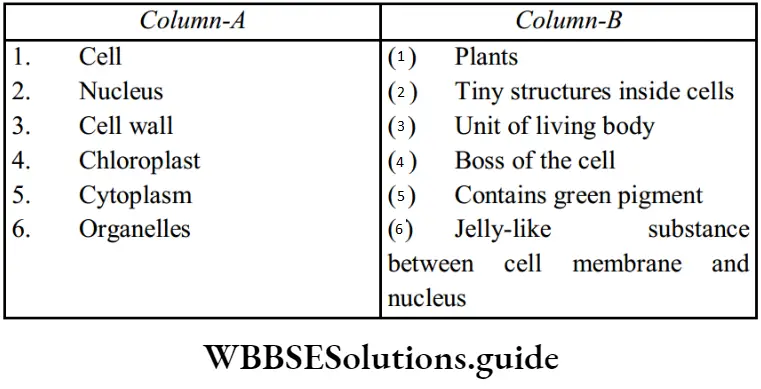Basic Biology Formative Worksheet
Question 1. Which type of cells did Robert Hooke observe under the microscope?
- Cork cells
- Leaf cells
- Muscle cells
- Liver cells
Answer: 1. Cork cells
Question 2. Robert Hooke studied the cork cells during his famous discovery of plant cells. The term ‘cell’ was coined by him. Which cell structure was observed by Robert Hooke when he studied cork cells?
- Nucleus
- Cell wall
- Cytoplasm
- Cell membrane
Answer: 2. Cell wall
Question 3. Which of the following alternatives describes the appearance of cells viewed by Robert Hooke for the first time?
- Honey comb-like structures
- Irregular mobile structures
- Elongated structures
- Spherical structures
Answer: 1. Honeycomb-like structures
Question 4. Cells form the basic units of life and are similar in structure in different living organisms. For example, cells present in the human brain, plant leaves, and the intestine of a cow are similar. The given cells are similar in structure due to the presence of
- Nucleus, cytoplasm, and cell wall
- Nucleus, cell wall, and cell membrane
- Nucleus, cell membrane, and cytoplasm
- Cytoplasm, cell wall, and cell membrane
Answer: 3. Nucleus, cell membrane, and cytoplasm
Question 5. Which of the following corresponds to the properties of a cell?
- The cell is the smallest living unit of life.
- It is so small that it is not visible to the naked eye.
- The shape of the cell varies in different organisms and within an organism.
- All
Answer: 4. All
Question 6. Which of the following corresponds to the principles of a cell theory?
- All living organisms are composed of one or more cells.
- Cells are the basic unit of structure and function in an organism.
- All cells come only from the reproduction of pre-existing cells.
- All
Answer: 4. All
Question 7. Which cell organelle controls the movement of particles in and out of the cell?
- Cell membrane
- Mitochondria
- Lysosomes
- Cytoplasm
Answer: 1. Cell membrane
Question 8. The flow of molecules in and out of a cell is regulated by
- Cell membrane
- Mitochondria
- Golgi body
- Nucleus
Answer: 1. Cell membrane
Question 9. Which of the following statements about cell membranes is correct?
- It controls all the activities of the cell.
- It carries out the process of photosynthesis.
- It stores the waste material produced by the cell.
- It regulates the movement of substances in and out of the cell.
Answer: 4. It controls all the activities of the cell.
Question 10. Which of the following functions holds true for the plasma membrane?
- It protects and gives structural support to cells
- It contains the genetic material
- It regulates substances moving in and out of cells
- It maintains the shape of cells
Answer: 3. It regulates substances moving in and out of cells
Question 11. Cytoplasm occupies less space in plant cells because of the
- Presence of cell wall
- Presence of vacuoles
- Absence of cell wall
- Absence of vacuoles
Answer: 2. Presence of vacuoles
Question 12. Which of the following statements about plasma membrane is incorrect?
- It is porous in nature.
- It is present in all cells.
- It allows the movement of substances in and out of cells.
- It takes part in the transfer of characters from parents to offspring.
Answer: 1. It is porous in nature.
Question 13. Which arrow diagram correctly illustrates the arrangement of cell organelles starting from the outermost layer of plant cells?
- Plasma membrane → cell wall → cytoplasm → nucleus
- Cell wall → plasma membrane → cytoplasm → nucleus
- Cell wall → cytoplasm → plasma membrane → nucleus
- Plasma membrane → cytoplasm → cell wall → nucleus
Answer: 2. Cell wall → plasma membrane → cytoplasm → nucleus
Question 14. The nucleus of a cell is a membrane-bound organelle that
contains the genetic material i.e., DNA. The cellular material present outside the nucleus is called cytoplasm. Which membrane separates the components of the nucleus and cytoplasm?
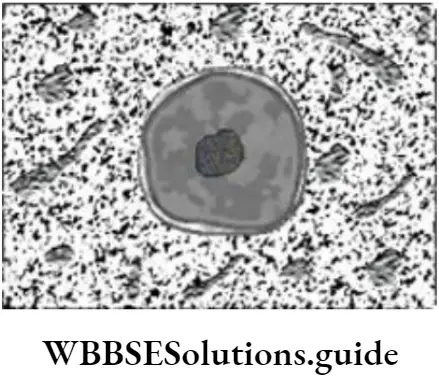
- Protoplasm
- Nucleolus
- Plasma membrane
- Nuclear envelope
Answer: 4. Nuclear envelope
Question 15. Which of the following statements about the nucleus is true?
- It allows the movement of substances both into and out of the cell.
- It holds information that is transferred from parents to offspring.
- It carries out the process of photosynthesis.
- It protects the cell from external injury.
Answer: 2. It holds information that is transferred from parents to offspring.
Question 16. Prokaryotes are distinguished from eukaryotes by the
- Presence of cell wall
- Absence of nucleus
- Presence of ribosomes
- Absence of chloroplasts
Answer: 2. Absence of nucleus
Question 17. The thread-like structures present inside the nucleus that are visible only during cell division are known as
- Genes
- Plastids
- Vacuoles
- Chromosomes
Answer: 4. Chromosomes
Question 18. A certain cell organelle controls various activities of the cell such as protein synthesis. It also contains the hereditary information of an organism. The described cell organelle is the
- Nucleus
- Ribosome
- Chloroplast
- Mitochondrion
Answer: 1. Nucleus
Question 19. The powerhouse of a cell is
- Nucleus
- Cell wall
- Lysosome
- Mitochondria
Answer: 4. Mitochondria
Question 20. The sites of production of ATP in mitochondria are
- Matrix
- Lipid membranes
- Cristae
- Both 1 and 2
Answer: 3. Cristae
Question 21. Which of the following is the function of mitochondria?
- They produce the energy required for cells in the form of ATP.
- They also regulate the free calcium ion concentration in the cytosol.
- They participate in apoptosis or programmed cell death.
- All the above
Answer: 4. They also regulate the free calcium ion concentration in the cytosol.
Question 22. Which cell organelle performs the following functions?
- To provide internal support to the cells
- To provide transportation pathways within the cells
- Chloroplast
- Endoplasmic reticulum
- Nucleus
- Ribosomes
Answer: 2. To provide transportation pathway within the cells
- Chloroplast
- Endoplasmic reticulum
Question 23. RER has _____ on its surface.
- Proteins
- Lysosomes
- Ribosomes
- Chlorophyll
Answer: 3. Ribosomes
Question 24. The given diagram illustrates a plant cell. Which labelled structure helps in the process of photosynthesis?
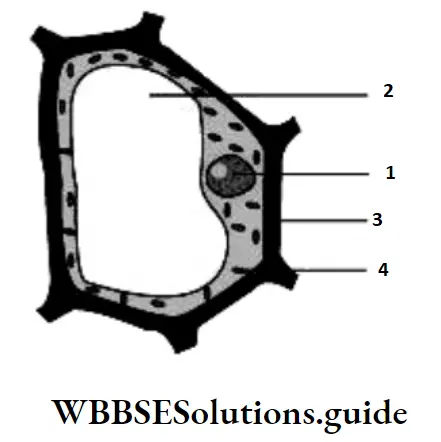
- 1
- 2
- 3
- 4
Answer: 4. 3
Question 25. Chloroplasts are green-coloured plastids found in the leaves of plants. They perform the function of
- Controlling the activities of the cell
- Carrying out photosynthesis
- Storing cellular waste
- Protecting the cell
Answer: 2. Carrying out photosynthesis
Question 26. Chlorophyll performs the function of
- Absorbing water in leaves
- Trapping light energy in leaves
- Releasing carbon dioxide into the atmosphere
- Releasing manufactured food into the atmosphere
Answer: 2. Trapping light energy in leaves
Question 27. Which of the following structures is present as “many in number” in a plant cell?
- Nucleus
- Vacuole
- Cytoplasm
- Chloroplast
Answer: 4. Chloroplast
Question 28. Which cell organelle produces glucose?
- Vacuole
- Lysosome
- Chloroplast
- Mitochondrion
Answer: 3. Chloroplast
Question 29. Who discovered the cell organelle that is involved in the transport of lipids within the cell?
- Robert Brown
- Rudolf Virchow
- Camillo Golgi
- Schwann
Answer: 3. Camillo Golgi
Question 30. Identify the cell organelle with the following functions.
- It involves the transport of lipids in cells.
- It involves the formation of lysosomes.
- It is involved in the synthesis of cell walls in the plant cell.
Choose the following option
- Mitochondria
- ER
- Golgi apparatus
- Plastids
Answer: 4. Plastids
Question 31. Suicidal bags of a cell are
- Ribosomes
- Lysosomes
- Chloroplasts
- Vacuoles
Answer: 2. Lysosomes
Question 32. The vacuole is a cell structure present in both plant and animal cells. Which of the following statements about plant and animal cell vacuoles is true?
- The plant cell has many small vacuoles, but the animal cell has one large vacuole.
- The plant cell has one large vacuole, but the animal cell has many small vacuoles.
- The plant as well as the animal cell has many small vacuoles.
- The plant as well as the animal cell has one large vacuole.
Answer: 2. The plant cell has one large vacuole, but the animal cell has many small vacuoles.
Question 33. Which of the following is found only in animal cells?
- Nucleus
- Cytoplasm
- Centrosome
- Mitochondria
Answer: 3. Centrosome
Question 34. The cell wall is present only in the plant cell. The main function of the cell wall is to
- Protect the cell
- Control cellular activities
- Carry out photosynthesis
- Perform cellular respiration
Answer: 1. Protect the cell
Question 35. Which of the following statements about the cell wall is correct?
- It controls all the activities of the cell.
- It carries out the process of photosynthesis.
- It protects the plant cell from variations in the temperature of the external environment.
- It contains thread-like structures called chromosomes, which take part in inheritance.
Answer: 3. It protects the plant cell from variations in the temperature of the external environment.
Question 36. Green plants produce oxygen which is utilized by all animals. The cell organelle that produces oxygen in a plant cell is the
- Mitochondrion
- Chloroplast
- Vacuole
- Nucleus
Answer: 2. Chloroplast
Question 37. Which of the following statements is/are correct?
- Unicellular organisms are formed of single cells
- Multicellular organisms are formed of many cells
- Millions of cells are present in plants
- All the above
Answer: 4. All the above
Question 38. The largest animal cell is
- Peacock egg
- Ostrich egg
- Crocodile egg
- Hen egg
Answer: 2. Ostrich egg
Question 39. The smallest animal cell is of
- POLO
- Ostrich egg
- Virus
- None
Answer: 1. PPLO
Question 40. Which of the following cells change their shape continuously?
- Amoeba
- Blood cells
- Nerve cells
- Both 1 & 2
Answer: 4. Both 1 & 2
Question 41. Which of the following is true for nerve cells?
- They change their shape continuously
- They are long and convey messages to different parts of the body
- They help in respiration and photosynthesis
- All
Answer: 2. They are long and convey messages to different parts of the body
Question 42. Identify the true statements.
- Mitosis takes place in vegetative cells
- Meiosis takes place in non-reproductive cells
- Cell division in plants occurs throughout their life
- Only 1
- Both 1 and 2
- Both 2 and 3
- Both 1 and 3
Answer: 4. Both 1 and 3
Question 43. The cell division responsible for the passing on of characters from the two parents to the child is
- Mitosis
- Meiosis
- Both
- None
Answer: 2. Meiosis
Question 44. The cell division that is responsible for the growth of an animal body is
- Mitosis
- Meiosis
- Both
- None
Answer: 1. Mitosis
Basic Biology Conceptive Worksheet
Question 1. Who observed cork cells under the microscope for the first time?
- Robert Hooke
- Robert Brown
- J.E. Purkinje
- J.M. Schleiden
Answer: 1. Robert Hooke
Question 2. Which part of a plant did Robert Hooke use to observe a cell using a microscope?
- Cork
- Leaf
- Root
- Flower
Answer: 1. Cork
Question 3. Which of the following facts about Robert Hooke’s experiment leading to the discovery of cells is not correct?
- He observed cells as honeycomb-like structures.
- He took the sample from the stem of a tree.
- He conducted his experiment in 1665.
- He observed living cells.
Answer: 1. He observed cells as honeycomb-like structures.
Question 4. Cell theory was proposed by
- Schleiden
- Schwann
- Both
- None
Answer: 3. Both
Question 5. Cell theory was expanded by
- Schleiden
- Schwann
- Rudolf Virchow
- All
Answer: 4. All
Question 6. The given illustration represents a cell. In the given illustration, the structure labelled X is
- Cell membrane
- Cell wall
- Vacuole
- Plastid
Answer: 4. Plastid
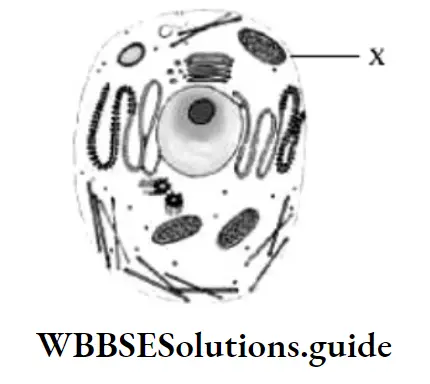
Question 7. Which of the following statements about cell membranes is incorrect?
- It regulates the entry and exit of substances in the cell
- It separates the cell from its surrounding medium
- It holds together the contents of the cell
- It controls all the functions of the cell
Answer: 1. It regulates the entry and exit of substances in the cell
Question 8. The given figure shows a labelled plant cell. In the given figure, the cytoplasm is labelled as
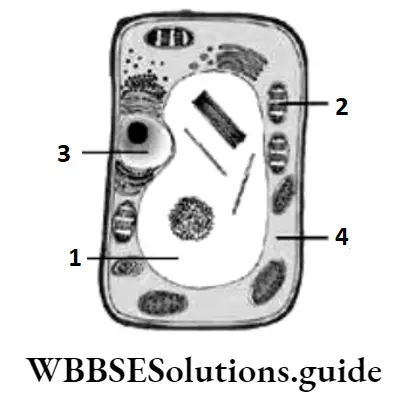
- 1
- 2
- 3
- 4
Answer: 1. 1
Question 9. The given diagram illustrates an animal cell. Which labelled structure in an animal cell controls all the cellular activities?
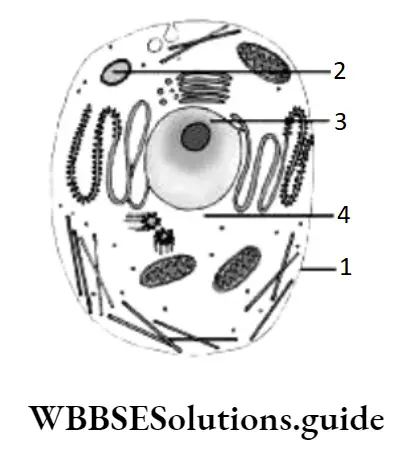
- 1
- 2
- 3
- 4
Answer: 3. 3
Question 10. The given figure illustrates structure X present in a cell. Which of the following alternatives represents the correct function of structure X?
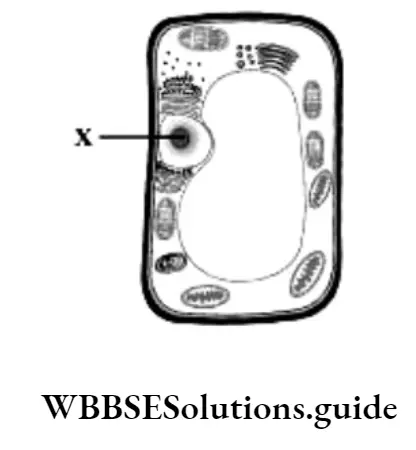
- To provide rigidity to the cell
- To provide turgidity to cell
- To help in energy synthesis
- To transfer the hereditary information
Answer: 4. To transfer the hereditary information
Question 11. The given diagram illustrates a cell. If the image illustrated represents a constituent cell of a multi-cellular animal, then the nucleus is labelled as
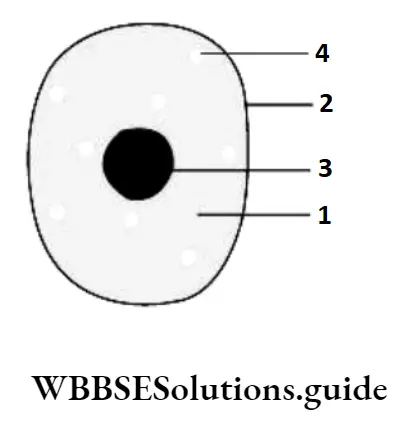
- 1
- 2
- 3
- 4
Answer: 1. 1
Question 12. Which of the following statements about prokaryotes is true?
- All prokaryotes have a cell wall
- Nucleus is absent in all prokaryotes
- Prokaryotes are larger than eukaryotes
- Ribosomes are larger in prokaryotes as compared to eukaryotes
Answer: 2. Nucleus is absent in all prokaryotes
Question 13. Which of the following statements about the nucleus is incorrect?
- It is surrounded by a membrane called a nuclear membrane.
- It contains thread-like structures called chromosomes.
- It is that part of the cell where food is stored.
- It takes part in the transfer of characteristics.
Answer: 3. It is that part of the cell where food is stored.
Question 14. The nucleus controls all life processes because of the presence of
- Nuclear membrane
- Nuclear pores
- Chromosomes
- Lysosomes
Answer: 3. Chromosomes
Question 15. Which of the following is responsible for the production of energy in eukaryotic cells?
- Nucleus
- Cell wall
- Lysosomes
- Mitochondria
Answer: 1. Nucleus
Question 16. Mitochondrial matrix contain
- DNA
- Ribosomes
- Both
- None
Answer: 4. None
Question 17. Cisternae are flattened disk-like membranous structures that are a part of
- Chloroplast
- Endoplasmic reticulum
- Nucleus
- Ribosomes
Answer: 2. Endoplasmic reticulum
Question 18. The given figure represents a plant cell. The labelled structure is present only in plant cells. In the given figure, label X represents
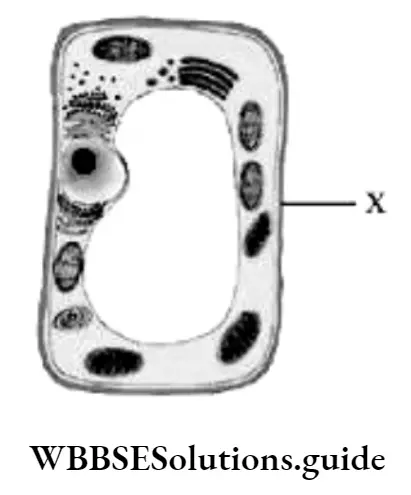
- Vacuole
- Nucleus
- Nucleolus
- Chloroplast
Answer: 2. Vacuole
Question 19. What is the primary function of chloroplast?
- Photosynthesis
- Food storage
- Cell division
- Protection
Answer: 1. Photosynthesis
Question 20. Carbon dioxide + Water → Glucose + Oxygen. The illustrated process occurs in the
- Mitochondria
- Chloroplasts
- Ribosomes
- Lysosomes
Answer: 3. Ribosomes
Question 21. Chloroplasts are cell organelles in plants which help to produce food for the plant. Which of the following is a source of energy used by chloroplasts to produce food?
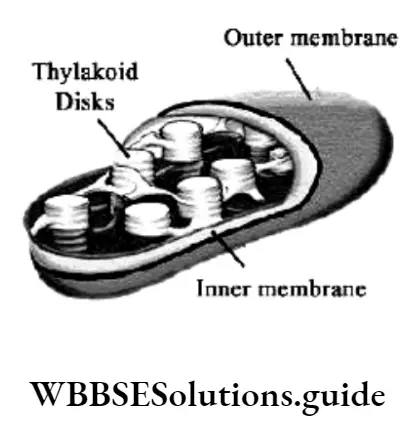
- Air
- Sun
- Soil
- Water
Answer: 2. Sun
Question 22. The Golgi apparatus present in plant cells is called
- Dictyosomes
- Chromosomes
- Plastids
- Centromeres
Answer: 1. Dictyosomes
Question 23. Which of the following cell organelles digest a variety of substances including worn-out organelles, food particles, viruses, and bacteria?
- Mitochondria
- Golgi apparatus
- Lysosomes
- Chloroplasts
Answer: 3. Lysosomes
Question 24. In the given figure, the structure labelled X is called
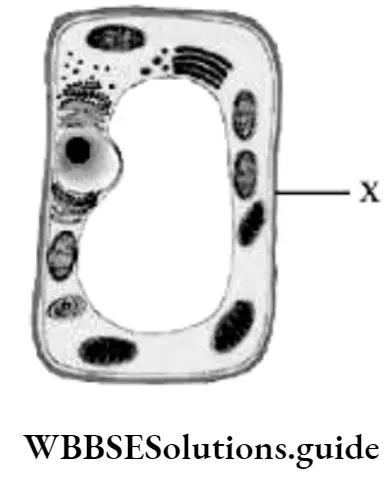
- Vacuole
- Nucleus
- Ribosome
- Chloroplast
Answer: 1. Vacuole
Question 25. In plant cells, the nucleus is found at the periphery of cells because of the presence of a central
- Plastid
- Lysosome
- Ribosome
- Vacuole
Answer: 4. Vacuole
Question 26. Jyoti drew a diagram of a plant cell and labelled one of its parts as X. Which cell component is labelled as X by Jyoti?
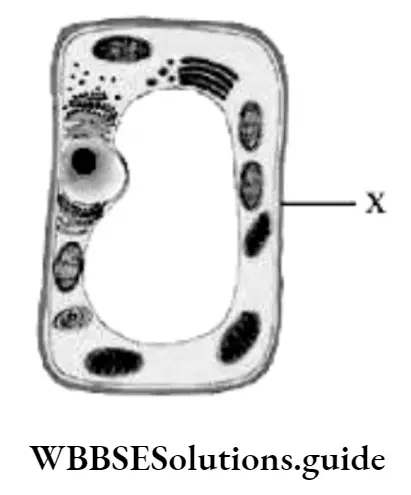
- Cell membrane
- Cell wall
- Nucleus
- Plastid
Answer: 2. Cell wall
Question 27. Which of the following structures is prominent in plant cells?
- Vacuole
- Centriole
- Ribosome
- Chloroplast
Answer: 1. Cell wall
Question 28. Division of labour is seen in
- Amoeba
- Bacteria
- Frog
- None
Answer: 4. None
Question 29. The size of an ostrich egg is:
- 170 × 25 mm
- 150 × 150 mm
- 170 × 135 mm
- 150×15mm
Answer: 3. 170 × 135 mm
Question 30. The size of PPLO is about
- 0.1 to 0.5 micron
- 1 to 5 microns
- 10 to 20 microns
- 100 to 200 microns
Answer: 1. 0.1 to 0.5 micron
Question 31. Growth and inheritance are the result of
- Mitosis
- Meiosis
- Both
- None
Answer: 3. Both
Question 32. In which of the following, the cell division take place throughout life?
- Frog
- Man
- Fish
- Neem plant
Answer: 4. Neem plant
Basic Biology Summative Worksheet MCQs
Question 1. The cell was discovered by
- Robert Brown
- Linnaeus
- Robert Hooke
- Darwin
Answer: 3. Robert Hooke
Question 2. Each cell has a
- Nucleus
- Cell wall
- Chloroplast
- All the above
Answer: 1. Nucleus
Question 3. The cell is surrounded by a membrane called
- Cell wall
- Cell membrane
- Cytoplasm
- Nuclear membrane
Answer: 2. Cell membrane
Question 4. Organelles are present in
- Cytoplasm
- Vacuoles
- Nucleus
- All the above
Answer: 1. Cytoplasm
Question 5. A cell organelle commonly called a ‘suicide bag’
- Nucleus
- Lysosome
- Chloroplast
- Ribosome
Answer: 2. Lysosome
Question 6. Robert Hooke was the first person to observe ____1_____ cells. He observed these cells using a ____2______. The information in which alternative completes the given statements?
- 1- cork 2- microscope
- 1- cork 2- magnifying glass
- 1- onion peel 2- microscope
- 1- onion peel 2- magnifying glass
Answer: 1. 1- cork 2- microscope
Question 7. The given figure depicts a diagram of a eukaryotic animal cell. It shows organelles labeled 1 and 2. The function of the part of the cell marked as I is to
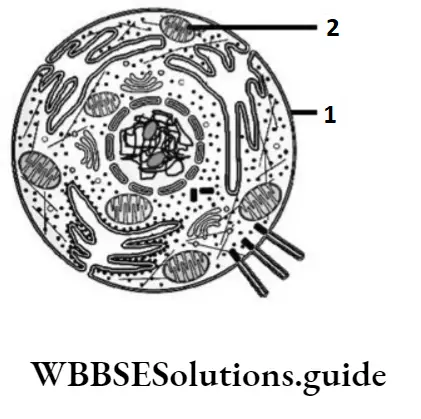
- Absorb energy from the sun and prepare food
- Perform aerobic respiration and synthesize acids
- Regulate the exit and entry of substances in the cell
- Control cell metabolism, and form ribosomes, DNA and RNA
Answer: 4. Control cell metabolism, and form ribosomes, DNA and RNA
Question 8. The cytoplasm is composed of all cell organelles except the nucleus. The contents of the nucleus are separated from the cytoplasm by the nuclear membrane. The nucleus and nuclear membrane together form nucleoplasm. Cytoplasm and nucleoplasm are together referred to as
- Protoplast
- Cytonucleus
- Protoplasm
- Nucleolus
Answer: 3. Protoplasm
Question 9. The nucleus is usually spherical in shape and is located at the centre of the cell. Which of the following statements about the nucleus is incorrect?
- It controls all the activities of the cell.
- It is surrounded by a porous nuclear membrane.
- It takes part in the transfer of characteristics from parents to offspring.
- It protects the plant cell from variations in the temperature of the external environment.
Answer: 3. It takes part in the transfer of characteristics from parents to offspring.
Question 10. Tarun draws the diagram of a cell and labels one of its components as X. The cell component labelled by Tarun is
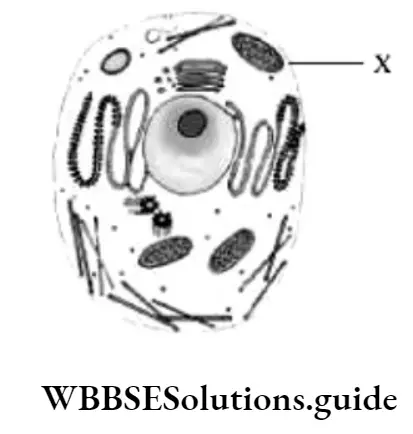
- Nucleolus
- Nucleus
- Vacuole
- Plastid
Answer: 4. Plastid
Question 11. Chloroplasts are cell organelles found mostly in all plant cells. Chloroplasts facilitate the process of
- Respiration
- Photosynthesis
- Lipid production
- Protein production
Answer: 1. Respiration
Question 12. ____1_____ is a type of plastid that is only present in plant cells. It carries out the process of ____2_____. The information in which alternative completes the given statements?
- 1- Chloroplast 2- photosynthesis
- 1- Vacuole 2- photosynthesis
- 1- Chloroplast 2- excretion
- 1- Vacuole 2- excretion
Answer: 2. 1- Vacuole 2- photosynthesis
Question 13. Which cell organelle produces oxygen?
- Mitochondrion
- Chloroplast
- Lysosome
- Ribosome
Answer: 2. Chloroplast
Question 14. The vacuole present in a plant cell differs from that of an animal cell because the former has
- Many small vacuoles
- Double membrane vacuole
- A single membrane vacuole
- A large centrally placed vacuole
Answer: 4. A large centrally placed vacuole
Question 15. The given illustration represents a cell. The function of protecting the cell from external injury is performed by the structure labelled
- 1
- 2
- 3
- 4
Answer: 3. 3
Question 16. Which figure represents a plant cell?
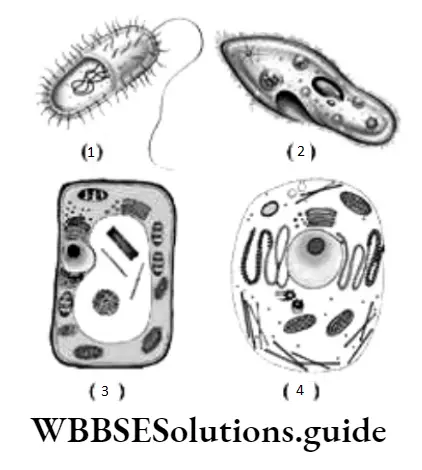
- 4
- 3
- 2
- 1
Answer: 2. 3
Question 17. The given figure illustrates five organelles of a cell. Which of the following groups represents the basic components of a cell?
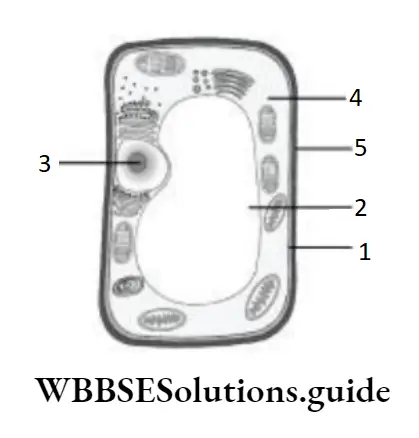
- 1, 2 and 3
- 1, 2 and 4
- 1, 3 and 4
- 3, 4 and 5
Answer: 3. 1, 3 and 4
Question 18. Cell membrane performs the function of
- Controlling the movement of materials in and out of the cell
- Manufacturing energy to carry out various functions
- Controlling the activities of the cell
- Storing food, water, and waste
Answer: 1. Controlling the movement of materials in and out of the cell
Question 19. Sunaina read in her science book that a jelly-like substance is present inside the cell, which is mostly made up of water. Which cell component did Sunaina read about?
- Nucleus
- Cell wall
- Cytoplasm
- Cell membrane
Answer: 3. Cytoplasm
Question 20. Sonali took a toothpick and gently scraped the inner side of her cheek with it.
- She placed the contents of the toothpick on a clean glass slide containing a drop of water and then added a drop of methylene blue stain to it.
- She gently placed a cover slip over the slide and observed the glass slide under the microscope. The given illustration represents the observation made by Sonali.
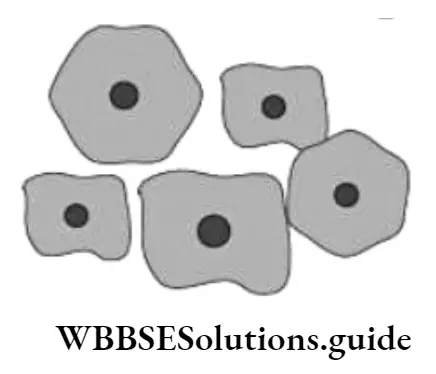
The darkly stained region of cheek cells represents the
- Nucleus
- Vacuole
- Cytoplasm
- Mitochondria
Answer: 1. Nucleus
Basic Biology Fill In The Blanks
using the words given below. One word can be used twice:
Egg, Microscope, Nucleus, Chloroplast, Cytoplasm, Cell membrane, Mitochondria, Robert Hooke, Plant
Question 1. The _____________ is the control centre of the cell.
Answer: NucleuS
Question 2. The instrument used to see tiny objects is called a__________.
Answer: Microscope
Question 3. __________ is called the kitchen of a cell.
Answer: Chloroplast
Question 4. An ________ is a cell that can be seen without a microscope.
Answer: Egg
Question 5. The _____________, ______________ and _________________ are parts of a cell.
Answer: Nucleus, Cytoplasm, Cell membrane, Mitochondria
Question 6. Energy is produced in _________________ cells.
Answer: Mitochondria
Question 7. The term cell was given by _________________.
Answer: Robert Hooke
Question 8. The cell wall is present in _________________.
Answer: Plant
Basic Biology Write True Or False
Question 1. Most cells have only one nucleus.
Answer: True
Question 2. Only the nucleus of a cell represents the protoplasm.
Answer: False
Question 3. Most cells are microscopic.
Answer: True
Question 4. All living organisms are made of cells.
Answer: True
Question 5. Cells must have a nucleus to live.
Answer: False
Question 6. Every cell has a cytoplasm.
Answer: True
Question 7. All cells in a multicellular organism can live independently.
Answer: False
Question 8. The outermost covering in an animal cell is called the cell wall.
Answer: False
Basic Biology Match The Following Columns
Answer: 1-3, 2-4, 3-1, 4-4, 5-6, 6-2

